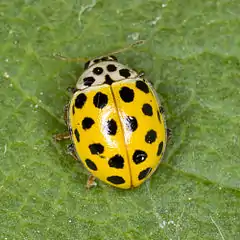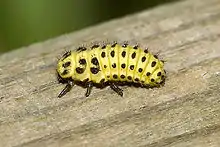Psyllobora vigintiduopunctata
Psyllobora vigintiduopunctata (often abbreviated to Psyllobora 22-punctata), the 22-spot ladybird, (earlier known as Thea vigintiduopunctata L.) is a 3–5 mm long ladybird commonly found in Europe .[2] The elytra are yellow in colour with 22 black spots. The pronotum is yellow or white with 5 black spots.[3] This ladybird species has been reported in other areas of the province of Kerman, Mazandaran, South eastern province of Khorasan, Chahar Mahal and Bakhtiari, in Mashhad, Gilan, Lorestan province, Khorasan.[4] Unlike most other ladybirds which feed on aphids, P. 22-punctata eats mildew — especially from umbellifers and low-growing shrubs .[5] The 22-spot ladybird is best looked for amongst low vegetation.[6]
| Psyllobora vigintiduopunctata | |
|---|---|
 | |
| Scientific classification | |
| Kingdom: | |
| Phylum: | |
| Class: | |
| Order: | |
| Family: | |
| Genus: | |
| Subgenus: | Thea |
| Species: | P. vigintiduopunctata |
| Binomial name | |
| Psyllobora vigintiduopunctata | |
A Finnish name of this beetle, 22-pistepirkko, is the origin of the name of the popular band.
References
- Linnaeus, C. 1758. Systema Naturae per regna tria naturæ, secundum classes, ordines, genera, species, cum characteribus, differentiis, synonymis, locis, Tomus I. Editio decima, reformata. Holmiæ: impensis direct. Laurentii Salvii. i–ii, 1–824 pp
- G. Bradley (2006). "22-spot ladybird". UK Safari.
- Ansari Pour A, Shakarami J. Recognition of ladybird fauna (Col.: Coccinellidae) in the alfalfa fields of Khorramabad. The Journal of Animal & Plant Sciences. 2012; 22(4):939-943.
- Ansari Pour A, Shakarami J. Recognition of ladybird fauna (Col.: Coccinellidae) in the alfalfa fields of Khorramabad. The Journal of Animal & Plant Sciences. 2012; 22(4): 939-943.
- Michael Chinery (1993). Collins Field Guide: Insects of Britain and Northern Europe. 3rd edition. HarperCollins. ISBN 0-00-219918-1.
- Mathias, Dilllen (April 18, 2017). "Stronger diversity effects with increased environmental stress: A study of multitrophic interactions between oak, powdery mildew and ladybirds". www.naturespot.org.uk. Retrieved 2019-07-22.

| Wikimedia Commons has media related to Psyllobora vigintiduopunctata. |
| Wikispecies has information related to Psyllobora vigintiduopunctata. |